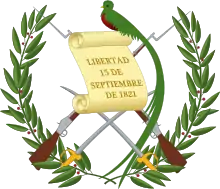National anthem of Guatemala
The national anthem of Guatemala (Spanish: Himno Nacional de Guatemala)[lower-alpha 1] was an initiative of the government of General José María Reina Barrios.[lower-alpha 2] Its music was composed by Rafael Álvarez Ovalle and its original lyrics written by Cuban poet and diplomat José Joaquín Palma, in the context of the cultural and idustrial event Exposición Centroamericana of 1897.
| English: National anthem of Guatemala | |
|---|---|
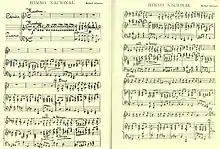 | |
National anthem of Guatemala | |
| Lyrics | José Joaquín Palma and José María Bonilla Ruano, 1896 (modified in July 1934 by the latter) |
| Music | Rafael Álvarez Ovalle, 1896 |
| Adopted | 19 February 1897 |
| Audio sample | |
| |
The anthem was particularly warmongering and reflected the Cuban War of Independence more than the independence of Central America.[1][2][lower-alpha 3] Due to this, by a 1934 order of President Jorge Ubico some changes to the lyrics were made by pedagogue José María Bonilla Ruano.
The lyrics and score were printed for the first time in the culture magazine La Ilustración Guatemalteca, where the original author of the lyrics appeared as "Anonymous".[3] It was not until 1910, shortly before his death, that Palma confessed being the author.
History
Origins
In 1879, the El Porvenir Literary Society unsuccessfully attempted to create a national anthem for Guatemala.[4][5] In 1887, the president of Guatemala, General Manuel Lisandro Barillas Bercián, called for a competition to choose music that would complement the lyrics of the "National Anthem" written by poet Ramón P. Molina. Distinguished composers took part in this competition, and the triumph was awarded to music presented by Rafael Álvarez Ovalle.[3][6]
Competition organised by Reina Barrios

In 1896, the government of General José María Reina Barrios called for a new competition, "considering that Guatemala lacks a National Anthem, since the one known to this day by that name not only suffers from notable defects, but also has not been officially declared as such; and that it is convenient to provide the country with an anthem that, through its lyrics and music, responds to the lofty purposes for which all educated people lend this kind of composition."[7][8] In this new competition, Rafael Álvarez Ovalle's work was chosen again, this time musicalising a poem written under the pseudonym "Anonymous".
The victory granted again to the teacher Álvarez Ovalle cost him the most bitter moments of his existence, as there was discontent among those who did not win, who even sent their complaint to the president. Reina Barrios, in the presence of the members of his cabinet, other figures and teachers of musical art, listened again to all the compositions that competed in the competition, and Álvarez Ovalle's was unanimously selected again.[9]
With respect to the lyrics, the qualifying jury determined the following:[8]
"Guatemala, 27 October 1896. Mr. Minister of Public Instruction. Present.
In compliance with the honourable commission with which you favoured us, taking charge of the qualification of the "national anthems" presented to this secretariat, by virtue of the competition opened by the agreement of the 24th of last July, we have examined the twelve compositions that with such objective you were kind enough to send us on the 15th of the current. Encouraged by best wishes, and with a view to making the appointment required by the aforementioned agreement, we have met several times, and after a long and careful examination, we have the honour to inform you that, in our opinion, the anthem that begins with the words Guatemala feliz and carries at the bottom the lyrics of "Anonymous" in parentheses is the one that best responds to the conditions of the call and deserves, therefore, the prize offered. Thus we have the honour of issuing the report that the secretariat of your worthy position requested of us, writing to us with all consideration and appreciation, the minister, very attentive and reliable servants.
José Leonard, J. J. Palma, F. Castañeda."
— Text of the report submitted by the qualifying jury of the literary competition, made up of F. Castañeda, J. Joaquín Palma and José Leonard.
As can be seen, Cuban poet José Joaquín Palma was a member of the qualifying jury.[8]
Palma's lyrics were officially adopted on 28 October 1896, while Álvarez Ovalle's music was officially adopted on 19 February 1897.[10][11] The premiere of the National Anthem took place in the literary lyrical act held at the Colón Theatre on the night of Sunday, 14 March 1897, as one of the main points of the programme of celebrations of the Exposición Centroamericana, with Álvarez Ovalle being decorated with a medal of gold and diploma of honour.[8]
Palma confesses to being the author
The author of the lyrics of the National Anthem of Guatemala remained a deep mystery until 1910, when it was discovered that its author was Cuban poet José Joaquín Palma, since he revealed on his deathbed that he was the author of the lyrics of the anthem.[12] The government of Manuel Estrada Cabrera awarded both him and Rafael Álvarez Ovalle with gold laurel wreaths at the Fiestas Minervalias that year.[1][8]
Lyrics
Original lyrics (1897–1934)
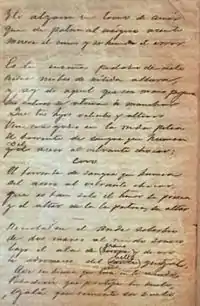
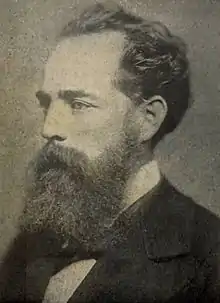
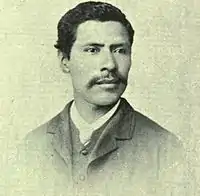
The original lyrics of the Guatemalan anthem written by José Joaquín Palma were warlike, since Palma was inspired more by the political situation his native Cuba was going through than that Guatemala experienced during its independence: while Central America separated from Spanish Empire peacefully, Cuba was waging a fierce war against Spain at the time Palma wrote the anthem.
| Spanish original[3][8] | English translation |
|---|---|
I |
I |
Current lyrics (1934–present)
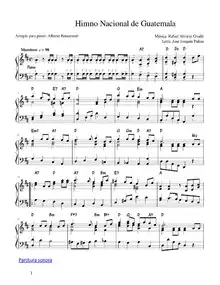
For not reflecting Guatemalan reality, Palma's lyrics were modified by Guatemalan poet and pedagogue José María Bonilla Ruano in 1934,[2] according to the Government Decree of 26 July 1934 by the government of General Jorge Ubico Castañeda.[11] These are the lyrics sung today.
| Spanish original[13][14] | English translation |
|---|---|
I |
I |
Certifications
The National Anthem of Guatemala has been considered by Carlos Labin, a member of the Americanist Society of Paris and the Musicology Society of France, as the "most original" of all the anthems of the American continent.[15]
Notes
- The anthem is often erroneously titled Guatemala Feliz!, from its opening lyrics, but it has no official name and is only referred to in the country as Himno Nacional
- President Manuel Lisandro Barillas had previously selected a different anthem a decade earlier but it was considered defective by President Reyna and replaced.
- José Joaquín Palma had actively participated in the Cuban independence effort.
- The stanza corresponds more to the Cuban War of Independence than the situation by which Guatemala became independent from Spain. Palma lived in Guatemala after being exiled from Cuba for his participation in the independence movement,[8] taking advantage of the fact that the government of Justo Rufino Barrios had recognised the independent government in exile in Cuba. Along with Palma, several distinguished Cubans settled in Guatemala, among them José Martí.
- Apparently, this stanza is based on the death of Cuban hero José Martí.
- This stanza is direct in its criticism of the Spanish administration in America.
- This stanza was modified to imply that the national flag was white, blue and white.
- Another reference to the situation in Cuba in 1897
References
- Bran Azmitia, Rigoberto (1972). Historia del Himno nacional de Guatemala (in Spanish). Guatemala: Comité Nacional Procentenario "Rafael Alvarez Ovalle,".
- Bonilla Ruano, Jose Maria (1935). Anotaciones críticodidácticas sobre el poema del himno nacional de Guatemala (in Spanish). Guatemala: Typographic Union.
- "Don Rafael Alvarez". La Ilustración Guatemalteca. Vol. 1, no. 17. Guatemala. 1897. p. 249. Retrieved 22 January 2022.
- Quiñónez, Edgar. "Himno Nacional de Guatemala: letra, historia y significado". República.gt (in Spanish). Retrieved 22 January 2022.
- "Rafael Alvarez Ovalle". Municipalidad de San Juan Comalapa (in Spanish). Retrieved 22 January 2022.
- "Unos versos dignos de un pueblo culto. (Primera Parte) - Departamento de Educación Departamento de Educación". Departamento de Educación (in Spanish). 4 March 2014. Retrieved 22 January 2022.
- Diario Oficial de la América Central (in Spanish). Guatemala: El Guatemalteco. 1896.
- "Unos versos dignos de un pueblo culto. (Segunda Parte) - Departamento de Educación Departamento de Educación". Departamento de Educación. 11 March 2014. Retrieved 22 January 2022.
- "Historia de Guatemala: Se estrena el Himno Nacional en 1897 – Prensa Libre" (in Spanish). Retrieved 22 January 2022.
- Recopilación de las Leyes de la República de Guatemala (in Spanish). Universidad Francisco Marroquín Biblioteca Ludwig von Mises. Tipografía Nacional. 1908. pp. 518–520.
{{cite book}}: CS1 maint: others (link) - "Decreto Numero 43-97" (PDF). Congreso de la República de Guatemala. Archived from the original on 22 November 2020. Retrieved 22 January 2022.
{{cite web}}: CS1 maint: unfit URL (link) - Hernández de León, Federico (1930). El Libro de las Efemérides (in Spanish). Guatemala: Tipografía Sánchez y de Guise.
- Cartilla cívica Libre al viento (in Spanish). Editorial Piedra Santa. 1991. pp. 59–60. ISBN 978-99922-58-06-4.
- Ruano, José María Bonilla (1935). Anotaciones críticodidácticas sobre el poema del himno nacional de Guatemala (in Spanish). Unión tipográfica. p. 12.
- Ministerio de Cultura y Deportes (24 October 2016). "El Día del Himno Nacional de Guatemala se conmemora en honor al autor de su música". Portal MCD (in Spanish). Retrieved 22 January 2022.
External links
- National anthem of Guatemala - Orchestra, choir, and lyrics in YouTube.
- Himno Nacional de Guatemala - Audio of the national anthem of Guatemala, with information and lyrics
